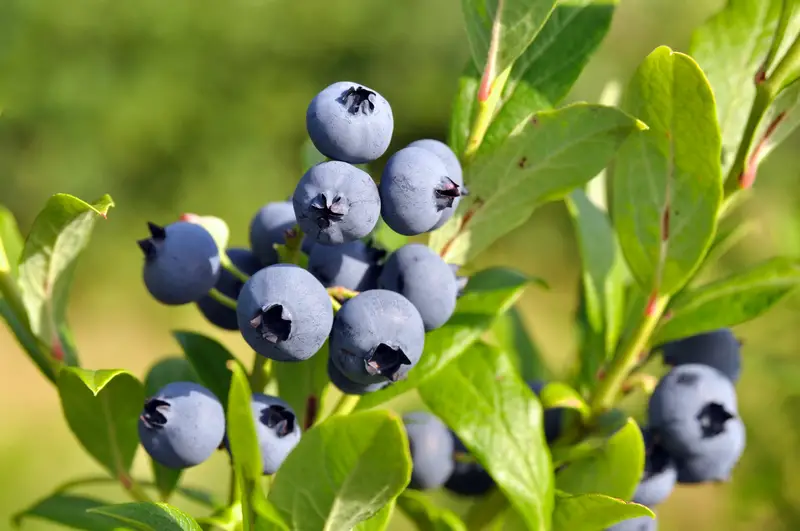Blueberry or Vaccinium corymbosum is a popular fruit that is rich in antioxidants. Healthy blueberry leaves put on a fabulous red color in the fall and that’s totally okay.
But in the spring, leaves should be bright green. So, if you are facing red leaves in the spring and ask why blueberries leaves turning red? We are going to discuss the most common cases about reddening blueberry leaves.
Moreover, there is an FAQ section in the end to rub-off your confusion.
Let’s go!

As an Amazon Associate I earn from qualifying purchases
What Causes Blueberries Leaves Turning Red?
If you notice blueberries leaves turning red in the fall, then there is no problem. It is a natural response to the cool weather. But, if you notice the same thing in the growing season (spring or summer), then yes, there’s a problem with your plant.
Let’s see what problem may be facing your blueberry plant:
- Phosphorus deficiency
- Magnesium deficiency
- Fungal disease
- Bacterial disease
- Cultural & nutrient problem
- Cold exposure
How To Stop Blueberry Leaves from Turning Red?
In this part, we are going to discuss the reasons why blueberry leaves turn red with effective solutions.
Problem 1: Phosphorus Deficiency
If your blueberry leaves are turning maroon to red in the spring, the reason can be phosphorus deficiency. Blueberries need acidic soil, pH should be 4.5-5.0. In case, your soil is over 5.2 of pH, the blueberry bushes won’t uptake enough phosphorus.
In such a situation, you will need to increase the acidity of your soil that will lead to alleviate the symptoms of phosphorus deficiency.
Solution: To increase soil acidity, add these following organic matter to your soil:
- Composted manure
- Coffee grounds
- Pine bark mulch
- Alfalfa Meal
- Dried leaves
- Peat moss
Problem 2: Magnesium Deficiency
The indication of magnesium deficiency is the veins of your blueberry leaves turning red. In case, your blueberry bushes can’t take in enough magnesium, they are in the lack of chlorophyll production.
In the very first place, the leaves’ veins will be turning yellow and over time, they will become bright red. The young leaves got affected firstly.
Solution: Applying Epsom salt around the blueberries will increase the magnesium levels in your soil.
Problem 3: Fungal Disease
Blueberries widely get affected by fungi, viruses, and bacteria. A point to be noted here, these are only concerns for a commercial grower Because there are large tracts of plants at risk of becoming infected.
There are many diseases that lead to red mottling or splotching of your blueberry leaves. Two of them are:
Phomopsis Twig Blight
In the very first few days, the twig (around the blighted bud) gets affected by a necrotic, brown lesion. After that, the leaves spots develop and the stems that are infected will wilt during summer. Also, their leaves will change color, from fresh, green to red or brown.
The final state of this problem can be a fruit rot at harvest, infected fruits split very easily and seem soft.
Solution: When it’s dormant season, prune and destroy the infected twigs. To limit the spread of the pathogen, avoid overhead irrigation. When leaf buds start breaking, applying lime sulfur can be effective.
Powdery Mildew
Powdery mildew is a fungal disease. A fungus named ‘Erysiphe vaccinii’ is liable for this. The first few days on the upper or lower surface of leaves are filled with white fluffy growth. Over time, leaves will start developing chlorotic spots with red borders and finally, will drop from the plants.
Solution: Powdery mildew is favored by warm and dry conditions. Apply foliar fungicides to prevent the disease.
Problem 4: Bacterial Disease
Bacterial diseases are often a common issue for any leaves to turn red. Such common issues are often seen among blueberry leaves. ‘Blueberry leaf scorch’- it’s the culprit you’re looking for here.
Xylella fastidiosa bacteria are responsible for this disease. The bacteria sap restricts the flow of water and nutrients in the plant. Infected plants are seen stunned and less productive. Flowering becomes irregular, leaves turn into red, and eventually die.
Solution: Must remove and destroy infected plants. Never make cuttings from infected plants. Applying neonicotinoid products such as thiamethoxam will be effective to prevent this disease.
Problem 5: Cultural & Nutrient Problem
As we discussed before, nutrient deficiency causes your blueberry leaves to turn red. Also, improper planting can cause reddening of blueberry leaves. However, these troubles are easier to shoot than the diseases.
Low levels of nutrients (e.g phosphorus or magnesium) causes leaves to turn red or purplish. And, nutrient shortage varies widely from location to location.
Solution: The plants growing in soggy and poorly drained soil should be relocated. Otherwise, amend the soil with pine bark and compost.
Problem 6: Cold Exposure
As we mentioned before, the leaves turn red in the fall because of a natural response to the cool weather. So, this type of discoloration will gradually fade when the temperature is warm.
But in case, the red leaf colors persist in spite of returning to the normal seasonal temperature, then another issue is likely to blame.
Frequently Asked Questions
Question: How often should I fertilize my blueberry plant?
Answer: You better do it once in late March, again in late May or early June. Also, foliar feed every other week after the weather is warm until June.
Question: Should I prune my blueberry plant?
Answer: Usually, there’s no need to prune blueberry plants about 3-4 years after planting it. But if you catch any disease, dead tips, or broken branch, then prune it.
Conclusion
So, that’s all we wanted to say to you. At the end of the article, you may no longer have any confusion about why your blueberries leaves turning red and how you can solve it.
Before closing, we want you to give a piece of advice. Always take extra care of your plant and be very careful about the maintenance.
Happy gardening!
